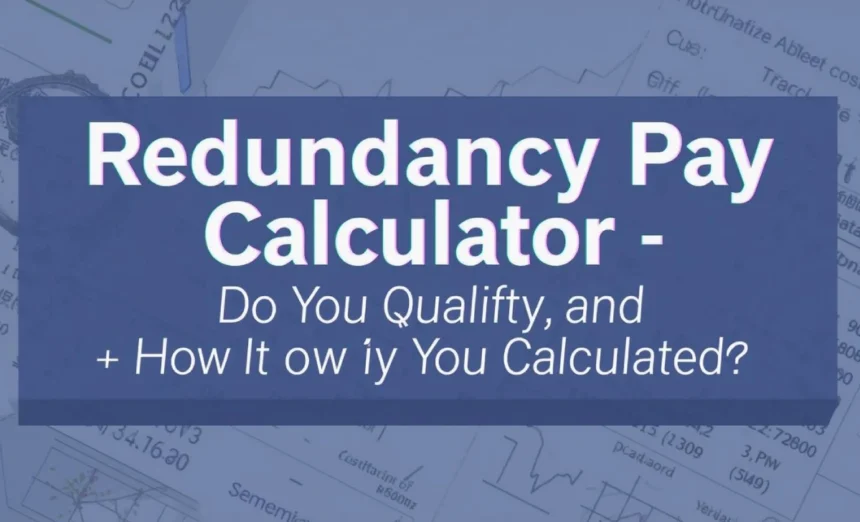Facing redundancy can be overwhelming, especially when you’re unsure if you qualify for redundancy pay or how much you should receive. Understanding your entitlements under Australian employment law is crucial for protecting your financial interests during this challenging time.
This comprehensive guide will walk you through Australia’s redundancy pay system, including who qualifies, how payments are calculated using the official Fair Work table, and provide you with a simple redundancy pay calculator Australia formula, plus real-world examples to determine your exact entitlements.
Who Qualifies for Redundancy Pay in Australia?
Under the National Employment Standards (NES), most Australian employees are entitled to redundancy pay, but specific eligibility criteria must be met.
To qualify for redundancy pay, you must have:
- 12 months of continuous service with your employer
- Been dismissed due to genuine redundancy (not misconduct or poor performance)
- Not been offered suitable alternative employment
Small business exception: Employers with fewer than 15 employees are generally exempt from NES redundancy pay obligations, though your award or enterprise agreement may still provide entitlements.
Continuous service includes periods of:
- Paid annual leave and sick leave
- Unpaid parental leave
- Workers’ compensation absence
- Casual employment (in some circumstances)
Real Aussie example: If you’ve worked continuously for 3 years at a Melbourne café with 20+ employees, you’ll meet the NES 12-month threshold and qualify for redundancy pay based on the Fair Work table.
Eligibility checklist:
• ✓ Employed for 12+ months continuously
• ✓ Dismissed due to genuine redundancy
• ✓ Employer has 15+ employees (or check your award)
• ✓ No suitable alternative employment offered
How Redundancy Pay Is Calculated (Using the Fair Work Table)
Calculating your redundancy pay calculator Australia entitlement involves two key components: your base rate of pay and the number of redundancy weeks based on your length of service.
Base rate of pay includes your ordinary hourly rate for regular working hours, but excludes:
- Overtime payments
- Penalty rates
- Allowances and bonuses
- Commissions
The Fair Work Commission determines redundancy weeks using a standardised table based on continuous service years. Your employer multiplies your weekly base rate by the applicable number of weeks.
Important note: In exceptional circumstances, employers can apply to the Fair Work Commission to reduce redundancy payments, though this requires demonstrating serious financial hardship.
Fair Work Redundancy Pay Table
The official NES redundancy pay scale provides the following weeks of pay:
| Years of Continuous Service | Redundancy Pay (Weeks) |
|---|---|
| At least 1 year but less than 2 years | 4 weeks |
| At least 2 years but less than 3 years | 6 weeks |
| At least 3 years but less than 4 years | 7 weeks |
| At least 4 years but less than 5 years | 8 weeks |
| At least 5 years but less than 6 years | 10 weeks |
| At least 6 years but less than 7 years | 11 weeks |
| At least 7 years but less than 8 years | 13 weeks |
| At least 8 years but less than 9 years | 14 weeks |
| At least 9 years but less than 10 years | 16 weeks |
| At least 10 years of continuous service | 12 weeks |
Note: The reduction to 12 weeks for 10+ years of service reflects the NES structure designed to balance employee protection with business sustainability.
Simple Redundancy Pay Formula + Calculator
Here’s the straightforward formula to calculate your redundancy entitlement:
Redundancy pay = Base rate of ordinary pay × Redundancy weeks (from Fair Work table)
Base rate calculation:
- Use your regular weekly wage for ordinary hours
- Exclude overtime, penalties, allowances, and bonuses
- For part-time employees, use actual weekly hours worked
DIY Calculator Framework:
Input fields needed:
- Employment type (Full-time/Part-time/Casual)
- Years of continuous service
- Weekly base pay (ordinary hours only)
- Award/enterprise agreement coverage (Yes/No)
Calculation process:
- Match service years to the Fair Work table weeks
- Multiply weekly base pay × redundancy weeks
- Output gross redundancy amount
Worked Examples Using the Calculator
Example A — Full-time café worker:
- 3 years continuous service = 7 weeks redundancy pay
- Weekly base pay = $900
- Calculation: 7 weeks × $900 = $6,300 redundancy pay
Example B — Administrative worker:
- 11 years continuous service = 12 weeks redundancy pay (NES 10+ years rule)
- Weekly base pay = $1,200
- Calculation: 12 weeks × $1,200 = $14,400 redundancy pay
| Example | Service Years | Weeks Due | Weekly Pay | Total Redundancy |
|---|---|---|---|---|
| Café Worker | 3 years | 7 weeks | $900 | $6,300 |
| Admin Worker | 11 years | 12 weeks | $1,200 | $14,400 |
Exceptions, Awards, Enterprise Agreements & Small Business Rules
The NES provides baseline protections, but several exceptions and variations can affect your entitlements.
Key exceptions include:
- Small businesses (under 15 employees) may be exempt from NES redundancy pay
- Some awards and enterprise agreements provide more generous redundancy terms
- Transfer of business situations may affect redundancy rights
- Reasonable refusal to accept suitable alternative employment
- Seasonal or project-based work arrangements
Enterprise agreement variations: Many workplace agreements provide redundancy entitlements above the NES minimum. Check your employment contract or speak with HR about applicable agreements.
Example: If your employer has 12 employees, NES redundancy may not apply — but your hospitality award could still require redundancy payments under different terms.
Common exception scenarios:
• Small business exemption (check employee headcount)
• Enhanced award/agreement entitlements
• Genuine operational transfer situations
• Reasonable alternative employment offers
Tax, Reporting and Genuine Redundancy (ATO Rules)
Understanding the tax implications of redundancy payments is crucial for financial planning.
Genuine redundancy tax treatment:
- Part of your redundancy payment may be tax-free up to ATO limits
- Tax-free component depends on years of service and statutory formulas
- Excess amounts are taxed as Employment Termination Payments (ETP)
- Specific reporting obligations apply to employers and employees
Current ATO tax-free thresholds: vary annually — check the Australian Taxation Office website for up-to-date figures before finalising calculations.
Your employer must provide a Payment Summary showing the tax-free and taxable components of your redundancy payment.
What to Do If You Think You’re Owed Redundancy
Taking action to secure your redundancy entitlements requires a systematic approach.
Step-by-step process:
- Use official tools: Start with the Fair Work Notice & Redundancy Calculator
- Request written calculation: Ask HR for a detailed redundancy payment breakdown
- Gather evidence: Collect payslips, employment contracts, and award/agreement documents
- Seek assistance: Contact the Fair Work Commission or a workplace lawyer if disputes arise
- Know your timeframes: Most employment disputes have strict time limits
Email template for requesting clarification: “Please provide a written calculation of my redundancy pay entitlement, including the base rate used, weeks calculated, and any deductions applied, in accordance with [relevant award/NES/enterprise agreement].”
Action checklist:
• ✓ Calculate entitlement using Fair Work tools
• ✓ Request written employer calculation
• ✓ Collect supporting documentation
• ✓ Understand dispute resolution timeframes
Conclusion
Understanding your redundancy pay entitlements doesn’t have to be complicated. By checking your eligibility against the 12-month continuous service requirement, using the redundancy pay calculator Australia formula with the Fair Work table, and following our worked examples, you can confidently determine what you’re owed.
For authoritative calculations, always verify your results using the Fair Work Notice & Redundancy Calculator and consult the ATO for current tax-free thresholds. If you believe you’re owed redundancy pay, don’t delay — use our calculator, download the eligibility checklist, and seek help from Fair Work if needed.

You qualify if you have at least 12 months of continuous service, your position is genuinely redundant, and your employer has 15+ employees (unless your award provides otherwise). You won’t qualify if you are dismissed for misconduct or offered suitable alternative employment.
Redundancy pay = Weekly base pay × Number of weeks (based on service years). Use the Fair Work table above to find your week’s entitlement. Base pay excludes overtime, penalties, and bonuses.
Genuine redundancy payments are partially tax-free up to ATO limits based on your years of service. Any amount above the tax-free threshold is taxed as an Employment Termination Payment (ETP). Check current ATO rates for specific amounts.
Employers with fewer than 15 employees are generally exempt from NES redundancy pay requirements. However, your industry award or enterprise agreement may still require redundancy payments regardless of business size.
You need at least 12 months of continuous service. Service between 1-2 years gets 4 weeks pay, 2-3 years gets 6 weeks, and so on, according to the Fair Work scale. The maximum is 16 weeks for 9-10 years, then 12 weeks for 10+ years.
In exceptional circumstances, employers can apply to the Fair Work Commission to reduce redundancy payments if they can demonstrate serious financial hardship. This requires formal approval and is not automatically granted.
If your employer offers you suitable alternative employment and you unreasonably refuse it, you may not be entitled to redundancy pay. The alternative role must be appropriate to your skills, location, and terms of employment.
Redundancy pay should be included in your final pay, typically paid on your last day of work or the next regular pay cycle. If there’s a dispute, contact Fair Work immediately as strict time limits apply.






